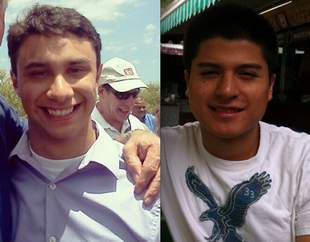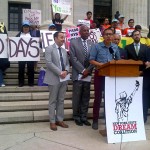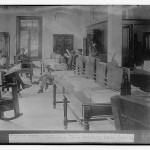
Leo Curiel, president of the College Democrats of Florida International University, and Daniel Oliva, president of the College Republicans of the John Jay College of Criminal Justice, New York. (Photos: ImpreMedia)
This story was written by Jesse Rogers and originally published on ImpreMedia’s Voto2012 blog.
NEW YORK — Ask two young Latinos – one a Republican, and the other a Democrat – about the prospects of boosting the Latino youth vote this fall, and the answer you get might be surprisingly similar.
Such is the case for Leo Curiel, 21, of Miami, and Daniel Oliva, age 20, from New York City. Both are political activists focused on getting out the vote in two states that occupy the third and fourth places, respectively, in terms of the number of Latinos eligible to vote in 2012. In Florida and New York, 1,650,000 and 845,000 Latinos will be able to vote this fall, according to the National Association of Latino Elected and Appointed Officials (NALEO).
While Curiel is president of the College Democrats at Florida International University in Miami, Oliva is the president of the College Republicans at the John Jay College of Criminal Justice in New York City.
In spite of differences in their political affiliations, the two young leaders are in agreement on at least one point – the necessity of getting young Latinos out to vote this fall, and the importance of making their voices heard by each of their parties’ candidates.
According to NALEO, 2.4 million Latino youth will turn 18 before November 6, gaining the right to vote for the first time. The sheer number of potential voters makes Latino youth a potentially powerful constituency for either party, if they can get to the polls, that is.
In 2008, an election year marked by historically high levels of participation by youth voters across the nation, 50% of the 3.5 million Latino youth eligible to vote within the ages of 18-24 were registered, and of these, only 39% turned out to vote, according to data from the U.S. census. This year, the number of eligible voters ages 18-24 has swelled to 5 million, according to the polling firm Latino Decisions, but registration rates are expected to be lower than 2008.
Curiel and Oliva also agree on the reasons why more young Latino voters tend not to vote. They say that the young voters they meet are often discouraged by Congress’ inaction on immigration reform and other issues concerning youth in general, such as student loans.
“Democrats have worked to advance the needs of the Latino community, especially in the area of health, but they haven’t brought forth a comprehensive immigration reform,” said Curiel, who came to the United States from Venezuela with his parents in 2003 and expects to become a naturalized citizen in time to vote in November.
Daniel Oliva, in New York, agrees. “Neither of the two parties have showed a willingness to address the problems that are the most serious for Latino youth, such as immigration and federally subsidized student loans,” said Oliva, the son of immigrants from El Salvador. Like many Latino youth, Oliva says, he started to become interested in politics with the election of Marco Rubio as a senator from the state of Florida.
In spite of these challenges, the two activists believe that enthusiasm among Latino youth will grow as the primary season shifts into the general campaign, and are optimistic about the process of motivating new voters.
“Other Latino youth are just as worried about the state of the country as us, we only have to change the ways we reach out to them and engage them,” Curiel concluded.
Fi2W is supported by the New York Community Trust and the John S. and James L. Knight Foundation with additional support from the Ralph E. Odgen Foundation and the Sirus Fund. Fi2W podcasts are supported by WNYC, New York Public Radio and the CUNY Graduate School of Journalism.



